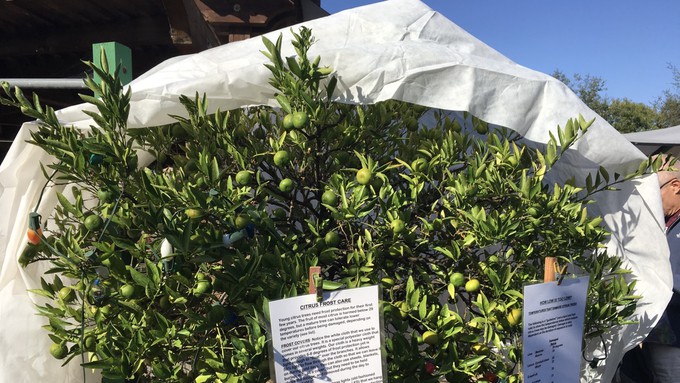
Overnight lows near freezing put poinsettias at risk

This display by the Sacramento County master gardeners shows how to protect a young citrus tree with frost cloth and/or old-fashioned Christmas lights. In practice, the cloth would be pulled completely over the tree on all sides. Kathy Morrison
According to the National Weather Service, Sacramento and its surrounding areas can expect areas of frost in the early hours of the morning Saturday through Tuesday. We’re officially under a frost warning from 11 p.m. Friday through Saturday morning.
Overnight lows are expected to dip into the low 30s every night from Friday through Tuesday.
“Near to below freezing overnight/morning temperatures will return to the Valley tonight and continue through the middle of next week,” tweeted the NWS Sacramento office on Friday morning. “Be sure to take the necessary precautions to protect pets, plants and people, especially for the vulnerable populations!”
In Sacramento, the lowest temperature currently predicted is 33 degrees in the wee hours of Tuesday morning. That’s not quite freezing, but cold enough to burn the leaves and bracts of tender poinsettias. It also can speed the decay of decorative pumpkins. To avoid damage to either, bring them indoors.
Also provide frost protection for tender new seedlings such as newly transplanted cabbage or lettuce. Slip a plastic milk jug over the whole plant; it becomes an instant mini greenhouse.
Provide protection for succulents or any remaining pepper or tomato plants. They’ll definitely feel the chill.
Bring container plants indoors or put under cover. Use cloth sheets (not plastic) for temporary protection. Make sure to remove these sheets during the day so plants don’t overheat and smother.
Except for succulents, water frost-tender plants in the late afternoon before a chilly night is predicted. That extra moisture raises the soil temperature just enough to avoid frost burn.
For more tips on freezing and frost: https://ipm.ucanr.edu/PMG/GARDEN/ENVIRON/frostdamage.html.
Comments
0 comments have been posted.Sacramento Digs Gardening to your inbox.
Sites We Like
Garden Checklist for week of July 21
Your garden needs you!
* Keep your vegetable garden watered, mulched and weeded. Water before 8 a.m. to reduce the chance of fungal infection and to conserve moisture.
* Feed vegetable plants bone meal, rock phosphate or other fertilizers high in phosphate to stimulate more blooms and fruiting. (But wait until daily high temperatures drop out of the 100s.)
* Don’t let tomatoes wilt or dry out completely. Give tomatoes a deep watering two to three times a week.
* Harvest vegetables promptly to encourage plants to produce more. Squash especially tends to grow rapidly in hot weather. Keep an eye on zucchini.
* Pinch back chrysanthemums for bushy plants and more flowers in September.
* Remove spent flowers from roses, daylilies and other bloomers as they finish flowering.
* Pinch off blooms from basil so the plant will grow more leaves.
* Cut back lavender after flowering to promote a second bloom.
* It's not too late to add a splash of color. Plant petunias, snapdragons, zinnias and marigolds.
* From seed, plant corn, pumpkins, radishes, winter squash and sunflowers.